Document management software has become a crucial component of running a business in 2020. So many organizations are either going paperless, have remote employees, or both.
These new trends make it unrealistic to keep documents and paperwork in physical filing cabinets or boxes in an office.
Document management software allows you to declutter your office, improve security, and access files or data from anywhere. This software also enhances efficiency when sharing documents or collaborating with team members.
Are you ready to digitally upload, track, and securely archive your documents? You need document management software to achieve this.
Whether your company is going paperless, or you just want to digitize your records for improved organization, this guide has everything you need to know about DM software (DMS).
The 7 Best Document Management Software
There are hundreds, if not thousands, of document management solutions on the market today. Cloud storage tools like Google Drive or Dropbox could technically fall into this category as well.
But for the purpose of this guide, I focused on DMS for businesses. For this instance, there are really only seven solutions that I would recommend.
The reviews below include a brief summary, features, benefits, prices, and any potential drawbacks of each software. Use this as a resource to find the best document management software for your unique situation.
eFileCabinet
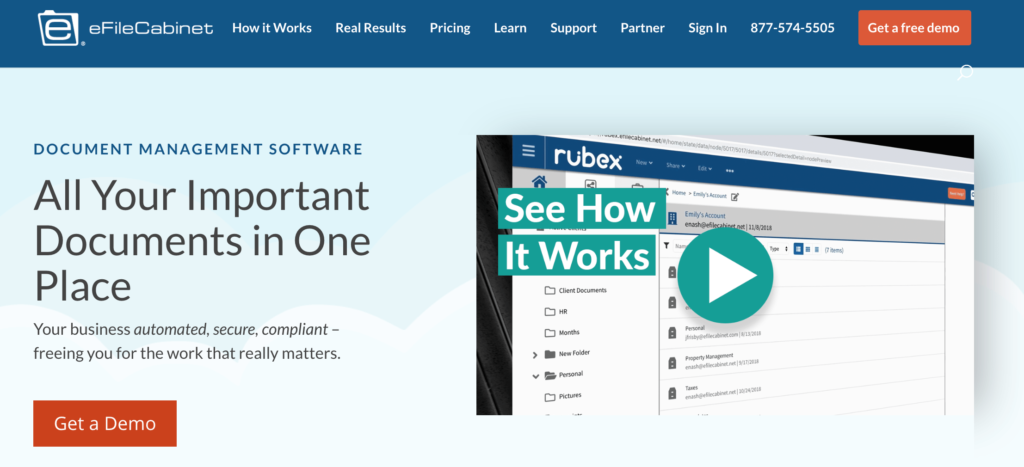
eFileCabinet is one of the best document management solutions on the market today. Since 2001, this company has helped individuals, small business owners, and enterprise-level companies organize data and files online.
The software makes it easy for you to stay organized and find a document, regardless of how many you have on file.
You can search for documents or locate them based on folder templates or pre-defined file names. eFileCabinet also keeps a portfolio of your most used documents for quick access.
The eFileCabinet solution does all of the hard work for you. Simply upload a document, and the software will file it for you. The automated workflow streamlines your time-consuming tasks to improve efficiency in the office.
All of your documents can be accessed from anywhere with a web browser or mobile app. You can upload documents directly from your phone using the camera on your device. eFileCabinet also allows you to sign contracts.
One of the biggest standouts for this solution is the collaboration features. The system allows you to create different levels of security, so only certain people can access data.
eFileCabinet has encrypted file sharing and requests, two-factor authentication, and role-based permissions. You can even set IP or location-based authentication.
The software integrates with popular third-party services like DocuSign, Salesforce, and Microsoft Office.
Here’s an overview of the plans and price points for eFileCabinet:
- Starter — Starting at $15 per month (25 GB of storage)
- Advantage — Starting at $55 per month (1 TB of storage)
- Business — Starting at $99 per month (5 TB of storage)
- Unlimited — Starting at $199 per month (Unlimited storage)
All prices are listed per user and billed on an annual basis. Once you upgrade from the Starter plan to Advantage, you’ll need to pay for a minimum of three users.
I’d only recommend the Starter plan to individuals. Sole proprietors or very small businesses can probably get away with the Advantage plan, but the Business package will likely be the best for the majority of you.
With eFileCabinet, you get to choose if you want your storage either on-site or on the cloud. Personally, I prefer the cloud storage. But there are advantages to on-premises as well.
M-Files

M-Files represents the future of document management. The software leverages AI technology to automate your organizing process.
When you upload content to M-Files, the platform automatically organizes the data based on what it is, as opposed to just where you want to store it.
You even have the ability to connect M-Files to your existing network and systems to protect your information and categorize everything with AI, automatically and securely.
Another top benefit of M-Files is that they offer industry-specific solutions. Some popular industries that they service include:
- Financial services
- Construction and engineering
- Oil and gas
- Real estate
- Manufacturing
- Professional services
M-Files is great for larger teams that need to access documents at different times. If someone on your staff needs a file that was uploaded and saved by another colleague, they won’t need to search through different folders to see what the document was saved as.
With AI technology, all you need to know is what type of document you’re looking for. Then you can organize the content based on criteria like project title, author, customer, or expiration date.
M-Files will automatically detect duplicate content. Rather than having multiple versions of the same or slightly different documents on your storage system, it will automatically update the latest document to one singular file. This way you always know that you’re viewing or working with the latest version.
With M-Files, you can store a wide range of document types, including emails. The software also allows you to collaborate with external users who don’t have M-Files. That content can be shared as a secure link.
M-Files offers cloud storage, on-site storage, and hybrid storage solutions as well.
You can try M-Files free for 30-days by filling out a form on their website. Pricing for M-Files is not listed on their website. You need to contact their sales team to inquire about a custom solution.
Templafy
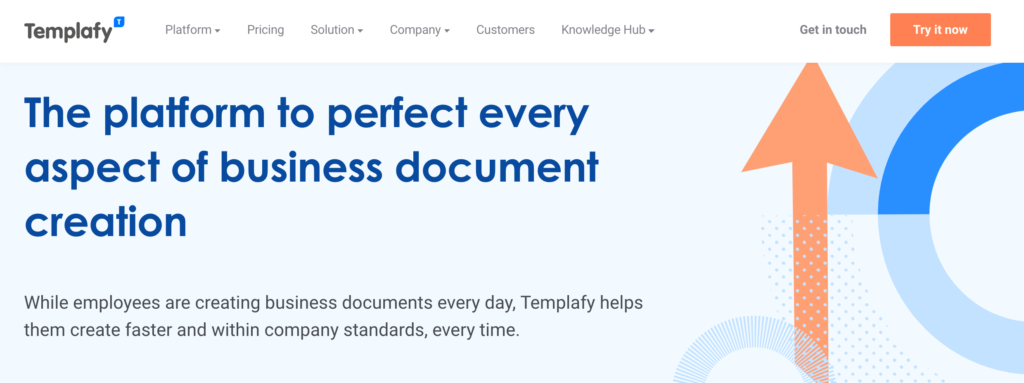
Templafy is a relatively new DMS. After launching in 2014, they have been providing all-in-one document management solutions for enterprises all over the world. It’s designed specifically for large businesses and helps streamline tasks to save time when it comes to storing and accessing files.
More than 300 enterprises across 80+ countries use Templafy for document management. This translates to more than one million users.
Using intelligence software, Templafy will automatically show the most relevant content to each employee based on their usage and position.
Your marketing team doesn’t need to see accounting documents, and vice versa.
One of the biggest pain points with DMS, in general, is having to create new documents using another platform. Templafy eliminates this pain point by giving users the ability to create and edit new content directly within the system.
Both new and uploaded content can all be managed in a simple and singular feed on your dashboard.
Templafy’s cloud storage software means you can access documents from anywhere, including on your smartphones and tablets.
You can integrate Templafy with Microsoft Office 365, G-Suite, and other platforms that you’re using to run your business on a daily basis. You can even integrate Templafy with CRM solutions like Salesforce or Microsoft Dynamics.
Big brands like Pandora and IKEA trust Templafy to manage their documents with enterprise-grade software.
In addition to managing documents and files, Templafy has solutions for maximizing employee productivity and creating an evergreen IT infrastructure.
Security is another top benefit of using Templafy. You and your team can securely store and access content from anywhere, using any device, whether you’re online or not.
Like most enterprise software, Templafy provides custom solutions for each unique company. So they don’t list any prices online. You can try Templafy for free before you commit to a contract by reaching out to their sales team.
DocuWare
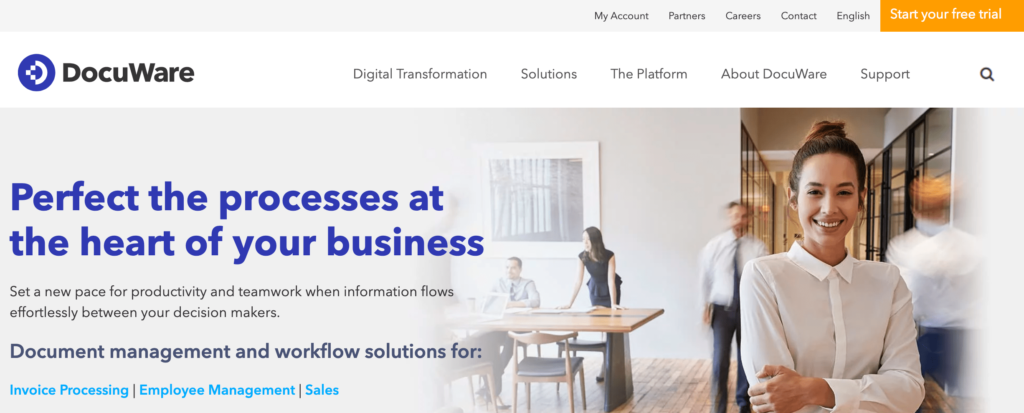
For those of you who are looking for a high-quality cloud-based solution for document management, look no further than DocuWare.
This DMS is unique because it has specific solutions for tasks within your business processes:
- Document management
- Invoice processing
- Employee management
- Sales
- Marketing
DocuWare has everything you need for digital transformation and going paperless using cloud technology.
This is another software that’s used by large businesses and enterprises. Sony, Toshiba, Levi’s, and Kellog’s are just a handful of their most well-recognized customers.
But with that said, DocuWare stands out as a top option for small and medium-sized businesses as well.
Small business owners can use DocuWare to automate their digital workflow, securely organize and store documents, and automate certain tedious tasks.
DocuWare allows you and your staff to edit or annotate documents directly on the platform. Not every DMS on our list gives you this capability.
I like DocuWare because it has features designed to connect remote employees and your deskless workforce. Anyone can easily access content at home or on the go from any device.
More than 12,000 businesses in 90+ countries trust DocuWare for document management. So you know that the company is legitimate with a track record like that.
It has specific use cases for things like contract proposals, finance processes, and HR tasks as well.
The pricing for DocuWare follows a common theme in this guide. They offer a free trial, but you need to contact their customer support team directly for a custom quote.
Hightail
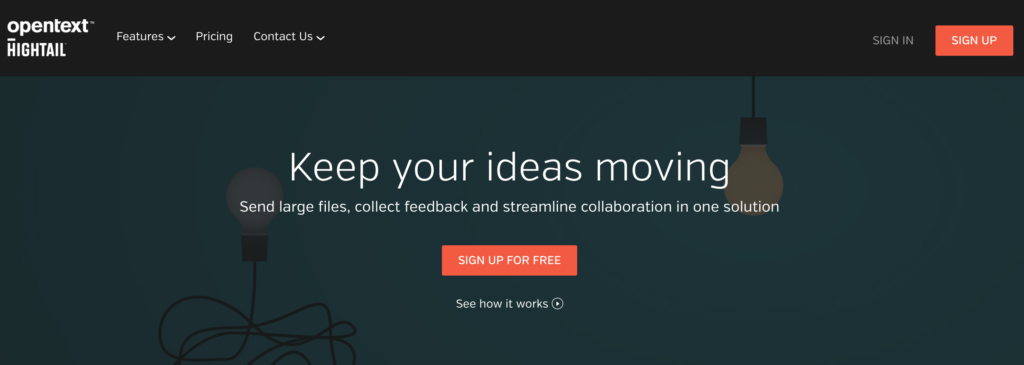
Hightail is a document management solution with a specific purpose—sharing and collaboration.
Other DMS on the market have features for file sharing as well, but Hightail takes this to the next level.
I recommend Hightail to businesses that need the ability to send large files securely.
Sharing is simple. Just drag or upload a file from your device or cloud storage solution into your Hightail account. Enter the information for who you want to share it with, and automatically send an email notification to the recipient.
With Hightail, you’ll be able to track the delivery and downloads of content you shared. So you know exactly who opened it and when.
Hightail lets you send files of up to 500 GB. You can add password protection to files and set expiration dates as well.
Here’s an overview of the plans and pricing for Hightail:
Lite — Free
- 100 MB file send limit
- 7 day file expiration
- Comments for feedback enabled
- Sync from third-party integrations
Pro — $12 per month per user
- 25 GB file send limit
- Configurable file expiration
- File previews enabled
- Send tracking and delivery notifications
- Password protection
- Phone and live chat support
Teams — $24 per month per user
- 50 GB file send limit
- Custom branding
- Organization and archiving tools
- Version control with side by side comparisons
- Real-time discussions for collaboration
- Members management
Business — $36 per user
- 500 GB file send limit
- Enterprise-grade security
- Dedicated customer support team
- Organizational level permissions
- Admin reports
As you can see, the pricing is largely based on the file sending limits. But the features get significantly better with each plan as well.
The free option is actually pretty good if you don’t need to send huge files, and even the entry-level Pro plan is suitable for a number of individuals.
If you’re interested in a paid plan, you can try Hightail free for 14 days.
MasterControl
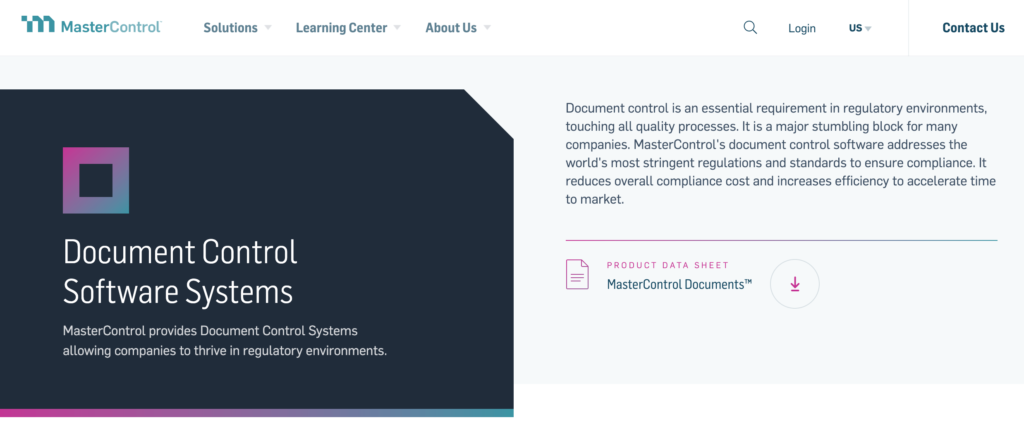
MasterControl is a DMS made for businesses where security is a top priority and concern. Certain industries have strict regulations for companies to comply with.
MasterControl understands those compliance concerns and created a document management solution that meets any security requirements.
One of the top features of MasterControl is its ability to track changes and revisions. If a document needs to be reviewed by a particular person, you can schedule a time and send out reminders as well.
MasterControl can also limit revisions based on access. You have complete control over who can make changes to a document.
You can also create custom watermarks, sequential numbering, and location tracking to control copies of your files.
MasterControl is 21 CFR Part 11 compliant. This means that documents have a time-stamped audit trail, as well as e-sign functionality that complies with federal regulations.
Another unique standout of MasterControl is its learning center. You’ll have access to tons of free videos, documents, and other resources to educate you about the platform and security compliance in general.
If you need enterprise-grade security for document management in a strict industry, MasterControl will be a top option for you to consider. Contact their sales team for a custom quote.
PaperTracer
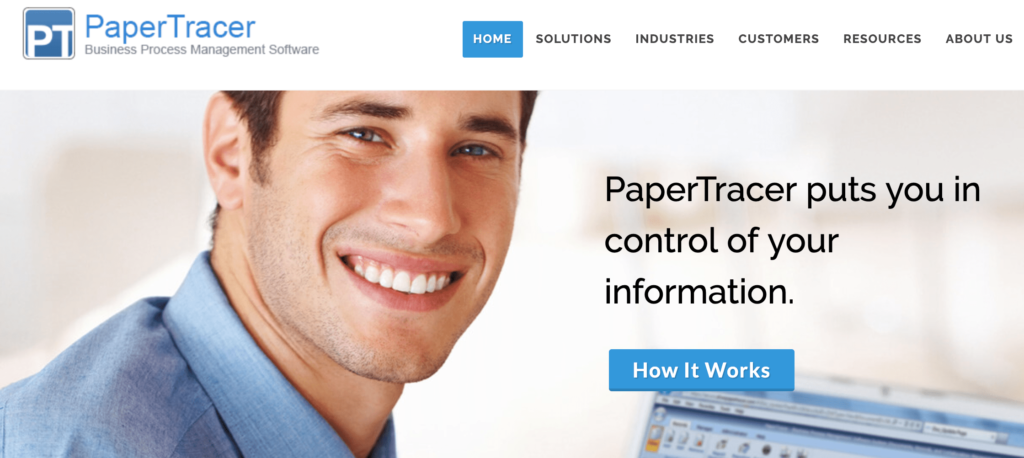
PaperTracer has solutions for small, medium, and enterprise-level businesses. It’s a simple solution for document management.
With PaperTracer, you’ll have the ability to automate your contracts and digitize all of your documents in a centralized database. PaperTracer has tracking and reporting capabilities and HIPPA compliant solutions as well.
Your document management solution is completely customized. You can benefit from a cloud-based implementation with end-to-end workflow solutions.
E-signature capability is also available with PaperTracer.
PaperTracer is a top solution for businesses in healthcare and legal industries.
Here’s a brief overview of the available plans, although all pricing is customized.
Small
- Up to 10 users
- Electronic signing
- Searchable database
- Upload and scan to PDF
- Advanced reports and dashboards
- Input forms
Mid Size
- Up to 100 users
- Contract authorizing
- Custom fields
- Custom workflows
- Implementation
Enterprise
- Unlimited users
- Unlimited input forms
- Single sign-on
Demos and free trials are available for all three plans. I’d recommend PaperTracer for small and medium-sized businesses. While they do have an enterprise-grade solution, there are better options for that on our list.
How to Find the Best Document Management Software
Choosing a document storage solution can be challenging if you don’t know what to look for. There are certain features and benefits that you need to keep an eye on when you’re evaluating a prospective software.
I’ll show you the methodology that we used to come up with the choices in this guide. You can use the same system to help narrow your search.
Storage Location
In most cases, document management solutions are either cloud-based or on-site. Some companies offer just one, while others let you choose which one you prefer.
For example, eFileCabinet offers both on-premises and cloud-based storage. M-Files has both as well, and also has a hybrid solution. Other solutions, like DocuWare are completely cloud-based.
I personally prefer cloud solutions because you can access content from anywhere. But for security reasons, some companies want files stored locally on their network.
File Sharing and Collaboration
What can you do with your files once they are uploaded and stored? While organizing files is obviously important, it’s useless for some companies if the documents can’t be shared with teams or external users.
Look for a DMS that accommodates your internal needs for editing or collaborating on files. Features like automated version updates and in-platform editing capabilities are crucial here.
The size of your files will also depend on which solution is best for your business. If you need to share large files, Hightail is the best choice.
Security
Most business-related files and data are sensitive. So it’s important to have a document management solution that can securely store information.
Some solutions offer access permissions based on individual clearance levels or even location.
Other platforms specialize in compliance for unique industries, like healthcare, legal, or government businesses.
Price
Pricing for DMS is usually based on storage limits and users. At each price tier, you can expect the plan to have additional features and benefits.
The majority of the solutions on this list offer custom plans and pricing. So to get a better idea of how much your document management software will cost, you’ll need to consult with a sales representative.
For those of you who are looking for a cost-effective solution and instant sign-ups, eFileCabinet will be a top choice for you to consider.
Integrations
Ideally, you want to find document management software that works with the platforms you’re already using. Whether it’s CRM like Salesforce, or document editing and creation software like Microsoft Office 365, certain platforms have a wide range of integrations for you to choose from.
However, other solutions that are niche-specific are a bit more limited. So make sure you use software that will actually benefit your workflow process.
Conclusion
Document management software is extremely diverse. Each solution offers unique benefits for businesses based on size, industry, or specific needs.
What’s the best document management software? It’s impossible to say since every option is so different. Here’s a quick recap of the platforms reviewed above:
- eFileCabinet — Best administrative controls and third-party integrations.
- M-Files — Best document management software for automated organizing with AI.
- Templafy — Best enterprise-grade document management software.
- DocuWare — Best cloud-based DMS for small to medium-sized businesses.
- Hightail — Best document management software for sending large files.
- MasterControl — Best DMS for strict security and compliance standards.
- PaperTracer — Best for small or medium-sized legal and healthcare companies.
If you’re looking for a basic all-in-one document management solution, eFileCabinet will probably be your best bet.
But for those of you with unique circumstances and needs, you can find custom software from one of the providers on our list.

Source Quick Sprout https://ift.tt/2u2o0Lz







